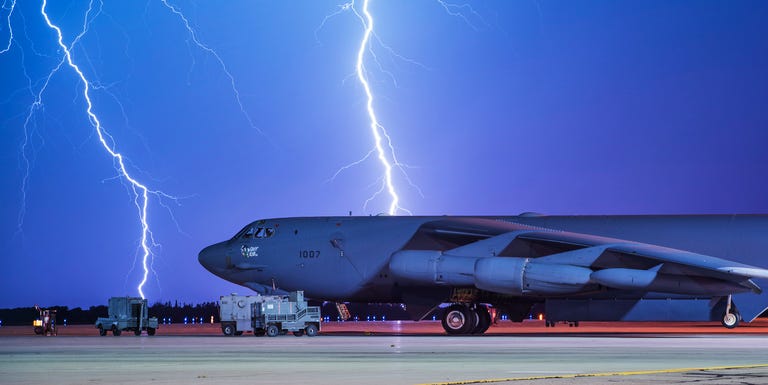The Air Force Wants to Install New Engines on the B-52 Bomber
The old warhorse needs new a new propulsion system to stay viable.

U.S. Air Force photo/Senior Airman J.T. Armstrong
By Kyle Mizokami
America’s fleet of B-52H Stratofortress nuclear bombers are on track to outlast their engines, and the planes need new ones to remain viable past 2030. The U.S. Air Force, which received its first B-52H during the Kennedy administration, wants to replace existing engines with cheaper, more power ones to keep the lumbering jets flying into all the way into the 2040s.
The B-52H is the last of the family of B-52 Stratofortress bombers to remain in U.S. service. The first -H model was delivered in 1961, and 76 of the original 102 bombers still fly with U.S. Air Force active and reserve units. The bombers have a range of 8,800 miles, giving them the ability to conduct strategic attack, close-air support, air interdiction, offensive counter-air and maritime operations worldwide. The bombers are capable of carrying both nuclear and conventional cruise missiles, and are set to carry the new Long Range Stand Off nuclear-tipped cruise missile in the future.
The B-52H fleet is still using its original Pratt & Whitney TF33-103 engines. Two of which hang off each of the bomber’s four engine stations, giving each aircraft eight such engines that combine to generate up to 136,000 pounds of thrust. As powerful as they are, the Pratt & Whitneys are growing old and increasingly difficult to maintain, and they have missed half a century of aircraft engine development. At $69,708 an hour to fly, the B-52 is an expensive bird to keep in the air. New engines could generate even more thrust, require less maintenance, and cost less per hour to fly.

B-52H bomber, with all eight TF-33 engines visible.
U.S. Air Force photo by Tech. Sgt. Richard P. Ebensberger
Aviation Week & Space Technology says that the Air Force wants to replace the TF-33-103 with a new commercial engine, like those used on commercial airliners, with a “20-40% improvement in fuel consumption compared to the TF33.” The new engine should also generate even more electricity for onboard systems, perhaps powering defensive lasers to shoot down air-to-air missiles. In the past, the Air Force has toyed with the idea of consolidating the number of engines to four to save weight and simplify things, but eight engines will provide more thrust and electrical power.
The Air Force has had on-again, off-again plans to reengine the B-52H fleet for decades, but the service’s 2018 budget finally provides funding for an early study. According to AvWeek, new engines would go on the first ten bombers around 2026, with the remaining 66 bombers refitted in the 2028-2034 time frame. The bombers would ideally stick around in Air Force service until 2050 or so, making them approximately 90 years old at their time of retirement.
Read more at Aviation Week & Space Technology
No comments:
Post a Comment